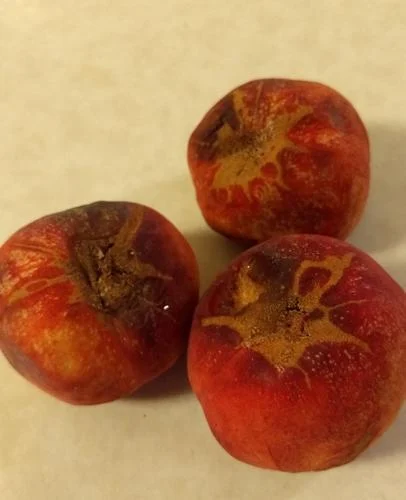Backyard fruit trees often need help to produce quality fruit
By Bonnie Orr
WSU Chelan/Douglas County Master Gardener


What a wonderful, snowy winter. It sometimes looks like the plants are tucked in and protected from the cold. They are dormant. So are all the diseases and insects that prey on the fruit trees.
It is a bit early to apply dormant sprays, but it is not too early to plan. The WSU Chelan County Master Gardeners can provide the information you need; you can email the program at chelanmastergardeners@gmail.com.
There is nothing as disappointing as seeing red “pimples” on the apricots, misshapen or rot in the middle of a beautiful peach or picking stunted plums. The very worst is finding a worm in a cherry or apple!
This damage can be eliminated by appropriately applying dormant and delayed dormant sprays that will control insect pests and diseases such as overwintering scales, aphids and mites. These sprays are oil based and smother overwintering fungal spores, bacterial blights, insects, larvae and eggs. These insects cause leaf damage such as leaf curl and leave unsightly and misshapen fruit.
Dormant sprays are applied to a bare tree before the buds show any activity. This is usually in late winter when the days are in the 40s and the nights are above freezing. The right day to spray will vary depending on where you live in North Central Washington.
Delayed dormant sprays are applied a few weeks later just as the buds begin to show the first green tissue when the daytime temperature is between 45 and 55 degrees and not freezing at night. Dormant pruning should be completed before you apply spray material so it is easier to see what you need to spray and so you don’t waste the spray.
You can treat your trees with conventional or organic materials. There are three types of spray schedules: dormant, delayed dormant and growing season. The WSU Master Gardeners have spray schedules with suggested spray materials. Email chelanmastergardeners@gmail.com to request a copy. Provide a phone number in the email so we can contact you and answer your questions.
Fruit trees often grow so large that they cannot be sprayed with a hose-end sprayer. In that case, commercial spraying is the option. The other option is to treat the tree with a chainsaw at the base. Really, isn’t 200 pounds of plums on a backyard tree a nuisance to deal with?
Since this column is discussing protecting fruit trees from pests, I will remind readers of the other required sprays for cherries and apples. Apples and cherries and pears are major agricultural crops in this area. An untreated backyard tree can damage the fruit in a commercial orchard. People often say, there are no orchards near me, so I don’t have to worry. But insects can fly or be blown for miles by the wind. Responsible backyard fruit growers hang pheromone traps to monitor for codling moths.
Pre-bloom sprays are applied when the flower buds show color but before the flower opens. These sprays control hatching insect pests such as aphids, stink bugs, scale, peach twig borer, pear psylla, various feeding caterpillars and coryneum blight, brown rot and powdery mildew. Whew! That is quite a list, isn’t it? So, you can see why this spray application is necessary.
If you were not aware of all the problems associated with growing backyard fruit, you may want to decide not to have backyard fruit trees. Yes, the shade is nice. The insects and diseases are not. Lovely fruit is delicious.
Remember that no sprays are applied when a fruit tree is in bloom. You do not want to kill the pollinators such as honeybees.
After the flower petals have fallen off, and the young fruit is barely visible, it is time again to spray for powdery mildew and aphids, scale, mites and feeding caterpillars.
Then, within 17-21 days after full bloom, apples and pears need to be sprayed on a regular schedule to control codling moth and pear psylla until the fruit is harvested. Cherry sprays to control cherry fruit fly and spotted wing drosophila start when the fruit turns from light green to yellow green and continues until all the fruit is ripe and removed from the tree.
It is never too early in the year to think about gardening.
